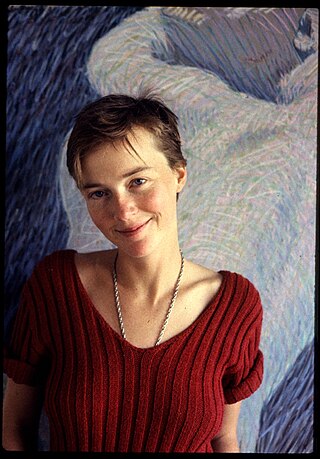
Adobe Photoshop is a raster graphics editor developed and published by Adobe for Windows and macOS. It was originally created in 1987 by Thomas and John Knoll. Since then, the software has become the most used tool for professional digital art, especially in raster graphics editing. Owing to its fame, the program's name has become genericised as a verb although Adobe disapproves of such use.

In European academic traditions, fine art is made primarily for aesthetics or creative expression, distinguishing it from decorative art or applied art, which also has to serve some practical function, such as pottery or most metalwork. In the aesthetic theories developed in the Italian Renaissance, the highest art was that which allowed the full expression and display of the artist's imagination, unrestricted by any of the practical considerations involved in, say, making and decorating a teapot. It was also considered important that making the artwork did not involve dividing the work between different individuals with specialized skills, as might be necessary with a piece of furniture, for example. Even within the fine arts, there was a hierarchy of genres based on the amount of creative imagination required, with history painting placed higher than still life.

Digital art refers to any artistic work or practice that uses digital technology as part of the creative or presentation process. It can also refer to computational art that uses and engages with digital media.

SmallBASIC is a BASIC programming language dialect with interpreters released as free software under the GNU General Public License version 3 for Microsoft Windows, Linux and Android.

3D Movie Maker is a children's computer program developed by Microsoft Home's Microsoft Kids subsidiary released in 1995. Using the program, users can make films by placing 3D characters and props into pre-rendered environments, as well as adding actions, sound effects, music, text, speech and special effects. Movies are then saved in the .3mm file format.

Clip art is a type of graphic art. Pieces are pre-made images used to illustrate any medium. Today, clip art is used extensively and comes in many forms, both electronic and printed. However, most clip art today is created, distributed, and used in a digital form. Since its inception, clip art has evolved to include a wide variety of content, file formats, illustration styles, and licensing restrictions. It is generally composed exclusively of illustrations, and does not include stock photography.
Filmmaking or film production is the process by which a motion picture is produced. Filmmaking involves a number of complex and discrete stages, beginning with an initial story, idea, or commission. Production then continues through screenwriting, casting, pre-production, shooting, sound recording, post-production, and screening the finished product before an audience, which may result in a film release and exhibition. The process is nonlinear, as the director typically shoots the script out of sequence, repeats shots as needed, and puts them together through editing later. Filmmaking occurs in a variety of economic, social, and political contexts around the world, and uses a variety of technologies and cinematic techniques to make theatrical films, episodic films for television and streaming platforms, music videos, and promotional and educational films.

Kid Pix is a bitmap drawing program designed for children. Originally created by Craig Hickman, it was first released for the Macintosh in 1989 and subsequently published in 1991 by Broderbund. Hickman was inspired to create Kid Pix after watching his son Ben struggle with MacPaint, and thus the main idea behind its development was to create a drawing program that would be very simple to use.

Toshio Iwai is a Japanese interactive media and installation artist who has also created a number of commercial video games. In addition he has worked in television, music performance, museum design and digital musical instrument design.

Microsoft Home is a discontinued line of software applications and personal hardware products published by Microsoft. The Microsoft Home brand was first announced by Bill Gates in a presentation on October 4, 1993. These applications were designed to bring multimedia to Microsoft Windows and Macintosh personal computers. With more than 60 products available under the Microsoft Home brand by 1994, the company's push into the consumer market took off. Microsoft Plus!, an add-on enhancement package for Windows, continued until the Windows XP era. The range of home software catered for many different consumer interests from gaming with Microsoft Arcade and Entertainment Packs to reference titles such as Microsoft Encarta, Bookshelf and Cinemania. Shortly after the release of Microsoft Windows 95, the company began to reduce the price of Microsoft Home products and by the rise of the World Wide Web by 1998, Microsoft began to phase out the line of software.

Creative Writer is a word processor released by Microsoft Kids in 1993. Using this program, which is specifically targeted at children, it is possible to create documents such as letters, posters, flyers and stories complete with different fonts, Clip art, WordArt and effects. The interface and environment is especially targeted towards children and is set in Imaginopolis with the main helper being a character known as McZee. A sequel, Creative Writer 2, was released in 1996. Both are now discontinued, but can still be acquired from online stores and auction websites such as eBay.
PC Paintbrush was a graphics editing software created by the ZSoft Corporation in 1984 for computers running the MS-DOS operating system.

Algorithmic art or algorithm art is art, mostly visual art, in which the design is generated by an algorithm. Algorithmic artists are sometimes called algorists.
Space art or astronomical art is a genre of art that focuses on the universe as a frame of reference. Like other genres, space art has many facets and encompasses Realism, Impressionism, Zoological art, abstract imagery, and the making of sculptures. Though artists have long produced art with astronomical elements, the genre of space art itself began only when technological advancement allowed for more detailed observation of the night sky. Space art also attempts to communicate ideas related to space, often including an artistic interpretation of cosmological phenomena and scientific discoveries. In some cases, space artists use more than illustration and painting to communicate astronomy or works depicting space. Several space artists some work directly with scientists developing spaceflight technology in attempts to expand the arts, humanities, and cultural expression relative to space exploration.

Creative Writer 2, known as Mon Atelier d'Écriture in French and Junior Schreibstudio in German, was a word processing program released in 1996 by Microsoft Kids. The interface was updated and the program was now designed for Windows 95.

Char Davies is a Canadian contemporary artist known for creating immersive virtual reality (VR) artworks. A founding director of Softimage, Co, she is considered a world leader in the field of virtual reality and a pioneer of bio-feedback VR. Davies is based in rural Quebec and San Francisco.

Miriam Schapiro was a Canadian-born artist based in the United States. She was a painter, sculptor, printmaker, and a pioneer of feminist art. She was also considered a leader of the Pattern and Decoration art movement. Schapiro's artwork blurs the line between fine art and craft. She incorporated craft elements into her paintings due to their association with women and femininity. Schapiro's work touches on the issue of feminism and art: especially in the aspect of feminism in relation to abstract art. Schapiro honed in her domesticated craft work and was able to create work that stood amongst the rest of the high art. These works represent Schapiro's identity as an artist working in the center of contemporary abstraction and simultaneously as a feminist being challenged to represent women's "consciousness" through imagery. She often used icons that are associated with women, such as hearts, floral decorations, geometric patterns, and the color pink. In the 1970s she made the hand fan, a typically small woman's object, heroic by painting it six feet by twelve feet. "The fan-shaped canvas, a powerful icon, gave Schapiro the opportunity to experiment … Out of this emerged a surface of textured coloristic complexity and opulence that formed the basis of her new personal style. The kimono, fans, houses, and hearts were the form into which she repeatedly poured her feelings and desires, her anxieties, and hopes".

Brian Peter George Eno, also mononymously known as Eno, is an English musician, songwriter, record producer and visual artist. He is best known for his pioneering contributions to ambient music and electronica, and for producing, recording, and writing works in rock and pop music. A self-described "non-musician", Eno has helped introduce unconventional concepts and approaches to contemporary music. He has been described as one of popular music's most influential and innovative figures. In 2019, he was inducted into the Rock and Roll Hall of Fame as a member of Roxy Music.

MicrosoftEncarta is a discontinued digital multimedia encyclopedia published by Microsoft from 1993 to 2009. Originally sold on CD-ROM or DVD, it was also available online via annual subscription, although later articles could also be viewed for free online with advertisements. By 2008, the complete English version, Encarta Premium, consisted of more than 62,000 articles, numerous photos and illustrations, music clips, videos, interactive content, timelines, maps, atlases and homework tools.
Microsoft Office shared tools are software components that are included in all Microsoft Office products.














